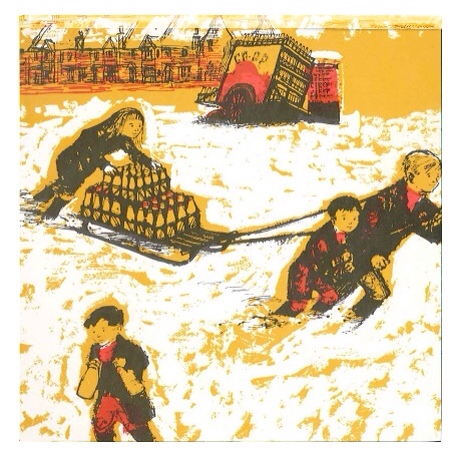‘It was early on Christmas morning and the snow was almost knee deep.’
Raymond Briggs’ very first snowbound adventure from 1963, Sledges to the Rescue takes place on Christmas day in the 1930s. It’s based on his own childhood memories of a time when milkmen used to do their rounds before they could enjoy their Christmas dinners, bringing milk and raspberry yoghurts to a nation that didn’t yet have to endure another rendition of ‘Walking in the Air
Ernie, isn’t the fastest milkman in the west, but an old man wracked with bronchitis. He’s unable to pull his heavy barrow through the thick snow and faces the prospect of missing Christmas altogether. But he doesn’t reckon on the local children, who gather together in a moment of seasonal kindness to make his deliveries by sledge.
Sledges to the Rescue is one of the first books that Briggs illustrated and wrote himself. Although it’s not exactly a classic piece of writing, the drawings are sublime and it provides some interesting examples of themes that he would return to throughout his career.

The character of Ernie is a version of his father Ernest, also a milkman for the Co-op who Briggs used to help out on his rounds as a child.

Most famously we meet Ernest crossing paths with Father Christmas as he is coming to the end of his own rounds. ‘Still at it mate?’ he asks cheerily.
The hand pulled barrow also appears in the illustrated biography of his parents, Ethel and Ernest. It’s interesting that Briggs chooses to depict Ernie as old as his real father would have been in 1963; by placing him in his own past he returns the ageing man to the arduous labour of his younger self, pulling the old cart by hand once again.
There’s a good deal of social realism in the story; the children may be little saints, but the hardness of life for working class families is unflinchingly portrayed. The sight of Ernie collapsed at the foot of his barrow is sad, but the later picture of him bundled and helpless onto the back of one of the children’s sledges is heartbreaking.
We finally meet Ethel, or Mrs Bowyer, waiting anxiously at the garden gate. Their touching reunion could have come straight out of another book about his parents, Gentlemen Jim.
‘Oh, Ernest, what a funny way to come home. You’re late too,’ she added.
‘I know, sorry ducks,’ said Ernie. ‘I felt a bit queer and couldn’t finish the round – and all these children did it for me so’s I’d get home in time for dinner.’
Re-reading Ethel and Ernest I was also struck by Briggs’ sometimes difficult relationship with his parents in the 60s. This solidly working class couple never quite got to grips with their son, the artist; worrying about the lack of job prospects and the long hair that came with his new life. It’s something that has clearly weighed on Briggs, as his writing has so frequently returned to pay homage to them. Sledges to the Rescue stands apart though as it was written during their lifetime and reads as a touching thank you note to his father.










